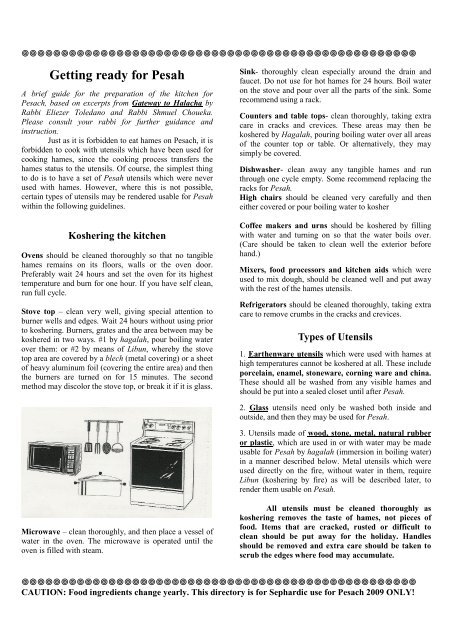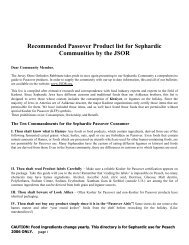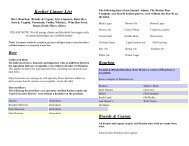2009 Recommended Passover Product list for Sephardic ... - JSOR
2009 Recommended Passover Product list for Sephardic ... - JSOR
2009 Recommended Passover Product list for Sephardic ... - JSOR
You also want an ePaper? Increase the reach of your titles
YUMPU automatically turns print PDFs into web optimized ePapers that Google loves.
Getting ready <strong>for</strong> Pesah<br />
A brief guide <strong>for</strong> the preparation of the kitchen <strong>for</strong><br />
Pesach, based on excerpts from Gateway to Halacha by<br />
Rabbi Eliezer Toledano and Rabbi Shmuel Choueka.<br />
Please consult your rabbi <strong>for</strong> further guidance and<br />
instruction.<br />
Just as it is <strong>for</strong>bidden to eat hames on Pesach, it is<br />
<strong>for</strong>bidden to cook with utensils which have been used <strong>for</strong><br />
cooking hames, since the cooking process transfers the<br />
hames status to the utensils. Of course, the simplest thing<br />
to do is to have a set of Pesah utensils which were never<br />
used with hames. However, where this is not possible,<br />
certain types of utensils may be rendered usable <strong>for</strong> Pesah<br />
within the following guidelines.<br />
Koshering the kitchen<br />
Ovens should be cleaned thoroughly so that no tangible<br />
hames remains on its floors, walls or the oven door.<br />
Preferably wait 24 hours and set the oven <strong>for</strong> its highest<br />
temperature and burn <strong>for</strong> one hour. If you have self clean,<br />
run full cycle.<br />
Stove top – clean very well, giving special attention to<br />
burner wells and edges. Wait 24 hours without using prior<br />
to koshering. Burners, grates and the area between may be<br />
koshered in two ways. #1 by hagalah, pour boiling water<br />
over them: or #2 by means of Libun, whereby the stove<br />
top area are covered by a blech (metal covering) or a sheet<br />
of heavy aluminum foil (covering the entire area) and then<br />
the burners are turned on <strong>for</strong> 15 minutes. The second<br />
method may discolor the stove top, or break it if it is glass.<br />
Sink- thoroughly clean especially around the drain and<br />
faucet. Do not use <strong>for</strong> hot hames <strong>for</strong> 24 hours. Boil water<br />
on the stove and pour over all the parts of the sink. Some<br />
recommend using a rack.<br />
Counters and table tops- clean thoroughly, taking extra<br />
care in cracks and crevices. These areas may then be<br />
koshered by Hagalah, pouring boiling water over all areas<br />
of the counter top or table. Or alternatively, they may<br />
simply be covered.<br />
Dishwasher- clean away any tangible hames and run<br />
through one cycle empty. Some recommend replacing the<br />
racks <strong>for</strong> Pesah.<br />
High chairs should be cleaned very carefully and then<br />
either covered or pour boiling water to kosher<br />
Coffee makers and urns should be koshered by filling<br />
with water and turning on so that the water boils over.<br />
(Care should be taken to clean well the exterior be<strong>for</strong>e<br />
hand.)<br />
Mixers, food processors and kitchen aids which were<br />
used to mix dough, should be cleaned well and put away<br />
with the rest of the hames utensils.<br />
Refrigerators should be cleaned thoroughly, taking extra<br />
care to remove crumbs in the cracks and crevices.<br />
Types of Utensils<br />
1. Earthenware utensils which were used with hames at<br />
high temperatures cannot be koshered at all. These include<br />
porcelain, enamel, stoneware, corning ware and china.<br />
These should all be washed from any visible hames and<br />
should be put into a sealed closet until after Pesah.<br />
2. Glass utensils need only be washed both inside and<br />
outside, and then they may be used <strong>for</strong> Pesah.<br />
3. Utensils made of wood, stone, metal, natural rubber<br />
or plastic, which are used in or with water may be made<br />
usable <strong>for</strong> Pesah by hagalah (immersion in boiling water)<br />
in a manner described below. Metal utensils which were<br />
used directly on the fire, without water in them, require<br />
Libun (koshering by fire) as will be described later, to<br />
render them usable on Pesah.<br />
Microwave – clean thoroughly, and then place a vessel of<br />
water in the oven. The microwave is operated until the<br />
oven is filled with steam.<br />
All utensils must be cleaned thoroughly as<br />
koshering removes the taste of hames, not pieces of<br />
food. Items that are cracked, rusted or difficult to<br />
clean should be put away <strong>for</strong> the holiday. Handles<br />
should be removed and extra care should be taken to<br />
scrub the edges where food may accumulate.<br />
<br />
CAUTION: Food ingredients change yearly. This directory is <strong>for</strong> <strong>Sephardic</strong> use <strong>for</strong> Pesach <strong>2009</strong> ONLY!





